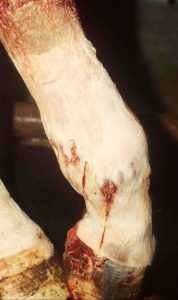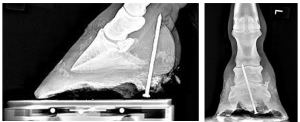Large animal wounds
Puncture wounds
Puncture wounds usually heal quickly and can even be missed by the animal’s caretaker unless complications develop. Complications include deep seated infections and foreign bodies. Foreign bodies will lead to persistent draining tracts and require surgical removal.
Infections can reach deeper tissues either primarily (direct injury) or secondarily (through extension as the infection builds). Infection in synovial structures can be hard to manage if diagnosis is delayed.

Puncture wounds can also lead to cellulitis – infection disseminated through the tissue planes.
“Streetnail” injuries are important injuries of the frog. Street nails are literally very big nails found in the street (or in the paddock, barn etc) that can end up puncturing the frog. These nails are often 2-4″ long and can reach deep into the foot.

Often, the nail is removed before you see the horse so you have more work to figure out where it went and what it damaged. It is often important to evaluate the navicular bursa, coffin joint and/or tendon sheath, depending on the direction of the nail.
Key Takeaways
Puncture wounds look innocuous and are often not. Train your clients to call you (or at least send pictures) regarding all wounds.

